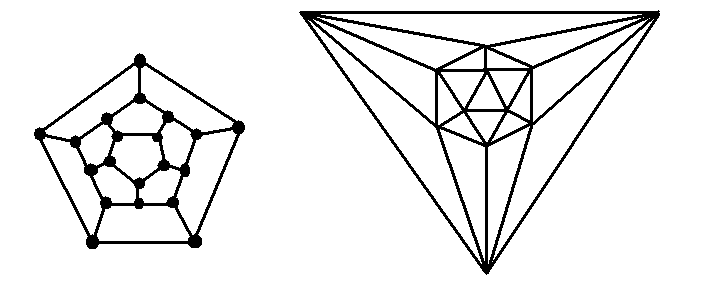
The text states that "symmetry and regularity lie at the heart of classical beauty." They claim that the most symmetrical object in the plane is a circle. If we require objects to have straight sides and seek symmetry, then we are lead to regular polygons. For any natural number n greater than or equal to 3 ("counting number"), there is a regular polygon with n sides:
In 3-D, the text comments that "the sphere is the most symmetrical of solids in space because it remains unchanged when revolved about any line through its center or reflected through any plane through its center." If we want solids with flat faces (to make something analogous to regular polygons), then we might expect again to get an infinite number of structures. However, we will prove (in Section 5.3) that there are only five of these 3-D structures, called Platonic solids.
The Platonic solids are the topic of Book XIII of Euclid's Elements (the final book). Some have commented that the whole purpose of the Elements was to establish that the five Platonic solids are the only regular solids. This seems unlikely, but reflects the fascination with these objects in classical Greece. In fact, Plato associated four of the Platonic solids, the tetrahedron, octahedron, icosahedron, and cube, with the four Greek elements: fire, air, water, and earth. They associated the dodecahedron with the universe as a whole. The mysticism affiliated with these objects continued, and around 1600, Johann Kepler tried to use the Platonic solids to describe the orbits of the then-known five other planets. He was unsuccessful in this endeavor (although our text seems to indicate otherwise). After abandoning the Platonic solids, he was successful in describing planetary orbits with his three laws of planetary motion.
We want each face of these 3-D structures to be regular polygons and the same number of edges to come together at each vertex ("corner"). With these requirements, we find that there are the following five solids: tetrahedron, cube, octahedron, dodecahedron, and icosahedron. We have the following properties:
(# sides s) | V | E | F | c |
|
Question. Can you find a way of calculating the number of vertices, V, once you know: the number of faces, F, and the number of sides of each face, s, and how many faces come together at a vertex, c?
Answer. Well, each face has s vertices and there are F faces, so initially we calculate sF vertices, but we have counted each of these several times. Since, at each vertex, there are c faces coming together, we have counted each vertex c times. So the total number of vertices is V=sF/c.
Question. Can you find the number of edges, E, from the other information?
Answer. Similar to above, each face contains s edges and there are F faces, so initially we calculate sF edges. But, each edge is contained in two faces, so the total number of edges is E=sF/2.
Notice that we can also deduce that 2E=sF, and so V=2E/c. Also F=2E/s.
In the area of math called "graph theory," an object called a graph is studied. A graph is a (finite) collection of dots called vertices and a collection of line segments, called edges, which join some of the vertices. The only properties of a graph are:

Question. Which of these graphs are planar?

Euler's Formula. For any connected planar graph, V-E+F = 2 where V is the number of vertices, E is the number of edges, and F is the number of regions.
This property may have been known to Archimedes (225 BC), and was very nearly stated by Descartes in 1695 (An Introduction to the History of Mathematics, Howard Eves). Euler presented the result in 1752.
The book motivates Euler's Formula (which it states as the "Euler Characteristic Theorem") by doodling and then concluding that when we add an edge to a graph, we also add either one vertex or one face.
Notice that if we have a planar graph drawn on a flat piece of rubber, then we can draw a large circle around the graph, cut it out, and then stretch the disk of rubber around a large sphere (without crumpling - though we will have to do some stretching and compressing). There will be a small isolated part of the sphere not covered. The book describes the process in reverse, starting by drawing a graph on a balloon and then punching a hole in the balloon and stretching it flat (so these processes are reversible). So any graph that can be drawn in the plane with no crossing of edges, can also be drawn on a sphere with no crossings (and vice-a-versa). Notice also that the number of regions is preserved.
Now let's relate the Platonic solids to spheres. This is fairly easy if we require the solids to be like balloons. We put a vertex at each corner of the solid and put edges between vertices which are joined by an edge of the solid. If we then inflate the solids they become like spheres. Notice that the resulting graphs drawn on spheres have no edges intersecting. Therefore, we can map a regular solid first to a sphere and then to a plane (and vice-a-versa). This leads us to consider the following planar graphs in connection with the Platonic solids:


For a regular solid, denote:
| 0 < 2 | = | V-E+F = 2E/c-E+2E/s |
| = | E(2/c-1+2/s) = E(2s/cs-cs/cs+2c/cs) | |
| = | E(2s-cs+2c)/cs. |
The text describes an additional property of Platonic solids. Suppose we put a vertex in the center of each face of a Platonic solid and join two vertices if they lie on faces that share an edge. One can show that this leads to another Platonic solid inscribed in the first. The smaller solid is called the dual of the larger one. We find the following.
Return to Bob Gardner's Foundations and Structure of Mathematics 1 webpage.